
Cut Costs, Save Time, and Gain Control Over AI Operations
AI tools are transforming businesses, but managing multiple systems often leads to inefficiencies, errors, and rising costs. Unified AI workflow platforms solve these issues by centralizing tools, improving security, and optimizing expenses. Below are five standout solutions that simplify AI orchestration while boosting productivity:
Quick Benefits:
Comparison Table:
| Platform | Key Features | Starting Price | Ideal For |
|---|---|---|---|
| Prompts.ai | Unified access to 35+ AI models, TOKN credits | $0/month (Pay-As-You-Go) | Teams managing diverse AI tools |
| Vellum AI | Model flexibility, real-time cost tracking | Custom Pricing | Developers and enterprises |
| Lindy AI | Agent-based workflows, natural language setup | Custom Pricing | Teams automating operations |
| n8n | 500+ integrations, hybrid no-code/low-code | Free/$20 per month | Small teams, technical users |
| Make | Drag-and-drop workflows, affordable plans | $9/month | Beginners and small businesses |
Choose the right platform to streamline your AI workflows, cut costs, and scale effectively.
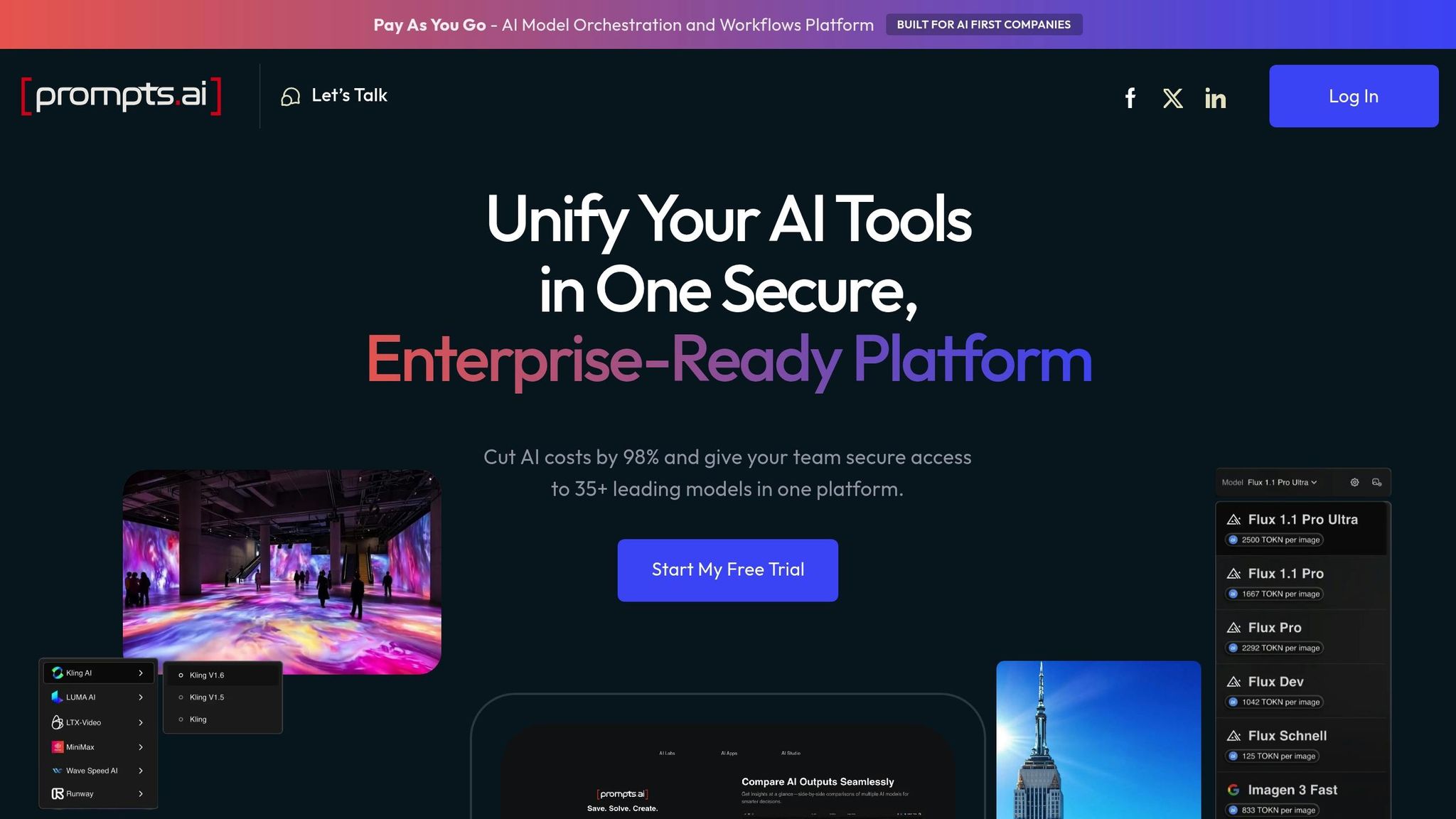
Prompts.ai serves as a centralized platform designed to bring order and efficiency to AI operations. By integrating multiple tools and models into a single ecosystem, it transforms scattered AI efforts into structured workflows with measurable results.
One of Prompts.ai's standout features is its ability to connect seamlessly with a wide range of AI tools. The platform provides unified access to over 35 top AI models, including GPT-4, Claude, LLaMA, and Gemini - all from a single interface. This eliminates the need to switch between platforms or manage multiple subscriptions. Beyond AI models, Prompts.ai integrates with popular business tools like Slack, Gmail, and Trello, enabling users to automate workflows and turn one-off tasks into scalable processes. It also includes a model comparison tool, allowing teams to evaluate and select the best large language models for their specific needs, ensuring efficient and effective AI use.
Prompts.ai places a strong emphasis on security and compliance, ensuring that AI operations are both safe and transparent. The platform adheres to industry standards such as SOC 2 Type II, HIPAA, and GDPR to protect user data. Through continuous SOC 2 Type II-compliant monitoring powered by Vanta, it provides users with confidence in its security measures. Features like role-based access control, audit trails, and workflow versioning ensure full transparency and accountability. Additionally, the platform includes compliance monitoring and governance tools in all its pricing plans. A dedicated Trust Center offers real-time insights into the platform's security posture, supporting users in managing their workflows securely and efficiently.
Prompts.ai also addresses the challenge of managing AI-related costs. By consolidating over 35 AI tools under one roof, it significantly reduces expenses through its usage-based TOKN credits system. This billing model ties costs directly to actual usage, avoiding the pitfalls of fixed subscriptions. Real-time analytics provide insights into resource consumption and spending, helping teams pinpoint inefficiencies, allocate resources wisely, and share credits across projects. This ensures that AI operations remain cost-effective and aligned with organizational needs.
Whether you're part of a small team or a large enterprise, Prompts.ai is built to scale. Its no-code/low-code interface makes it accessible to users of all technical backgrounds, while advanced users have the flexibility to expand its capabilities. The platform supports deployment in cloud environments, virtual private clouds (VPCs), and on-premises setups, catering to a wide range of operational needs. Its high-throughput workflow engine is designed to handle various use cases, from automating customer interactions to driving predictive analytics, enabling teams to streamline operations without limitations.
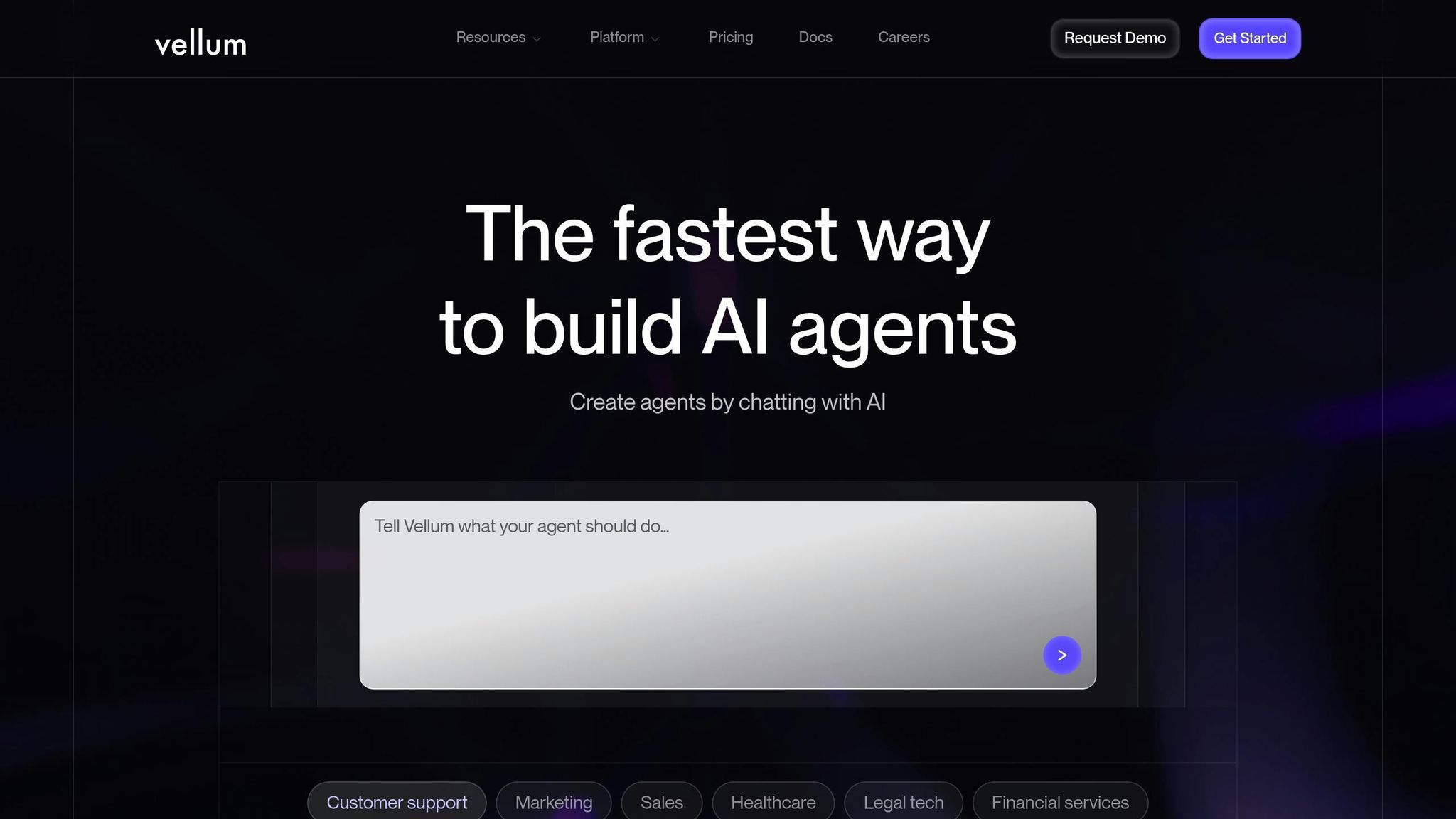
Vellum AI takes unified management a step further, focusing on seamless model integration and efficient development of AI applications. It equips developers and teams with the tools to build, test, and deploy AI workflows while keeping an eye on both performance and cost control.
Vellum AI connects with leading language models, including GPT, Claude, and open-source options like Llama 2. Its design allows users to switch between models within the same workflow, tailoring solutions to specific tasks without requiring a complete overhaul. This flexibility lets teams experiment with various AI providers and choose the best fit for each situation.
The platform also features a prompt engineering interface, enabling collaborative development and version control for prompts. Teams can create reusable templates, test them across multiple models simultaneously, and monitor performance metrics to identify the most effective configurations. This is especially useful for teams tackling complex AI projects that demand consistent results across diverse scenarios.
Vellum AI is built with enterprise needs in mind, offering robust governance tools. Its audit logging tracks every interaction, including model usage, prompt changes, and user activities, ensuring transparency and accountability.
With role-based access controls, administrators can define permissions, limiting access to sensitive workflows and prompts to authorized personnel. These controls are supported by approval workflows for prompt modifications, adding an extra layer of oversight before any changes are implemented in production.
The platform’s version control system extends beyond prompts to entire workflows. Teams can maintain multiple versions of their AI applications, revert to earlier configurations when needed, and compare performance across iterations to refine their solutions.
Vellum AI places a strong emphasis on cost management. Its real-time cost monitoring provides detailed breakdowns of expenses by model, user, and application. This level of detail helps teams pinpoint resource-heavy areas and focus optimization efforts where they matter most.
The platform’s model routing capabilities automatically direct requests to the most cost-effective model that meets quality standards. For example, simpler tasks are routed to less expensive models, while more complex workflows are handled by advanced options. This intelligent routing can lead to significant cost savings without sacrificing output quality.
Additionally, budget alerts help teams stay within financial limits, preventing unexpected overruns.
Vellum AI is designed to handle a wide range of use cases, offering scalability and flexibility. It supports both no-code and code-first approaches, making it accessible to non-technical users while still meeting the needs of developers.
The platform’s managed infrastructure automatically adjusts resources to handle high-demand periods, ensuring consistent performance without requiring teams to manage infrastructure themselves.
Its workflow orchestration features allow for the creation of complex, multi-step AI processes. Teams can combine different models, integrate business logic, and link external systems to build workflows tailored to their needs. Whether it’s a straightforward chatbot or a sophisticated document processing pipeline, Vellum AI provides the tools to bring these solutions to life.
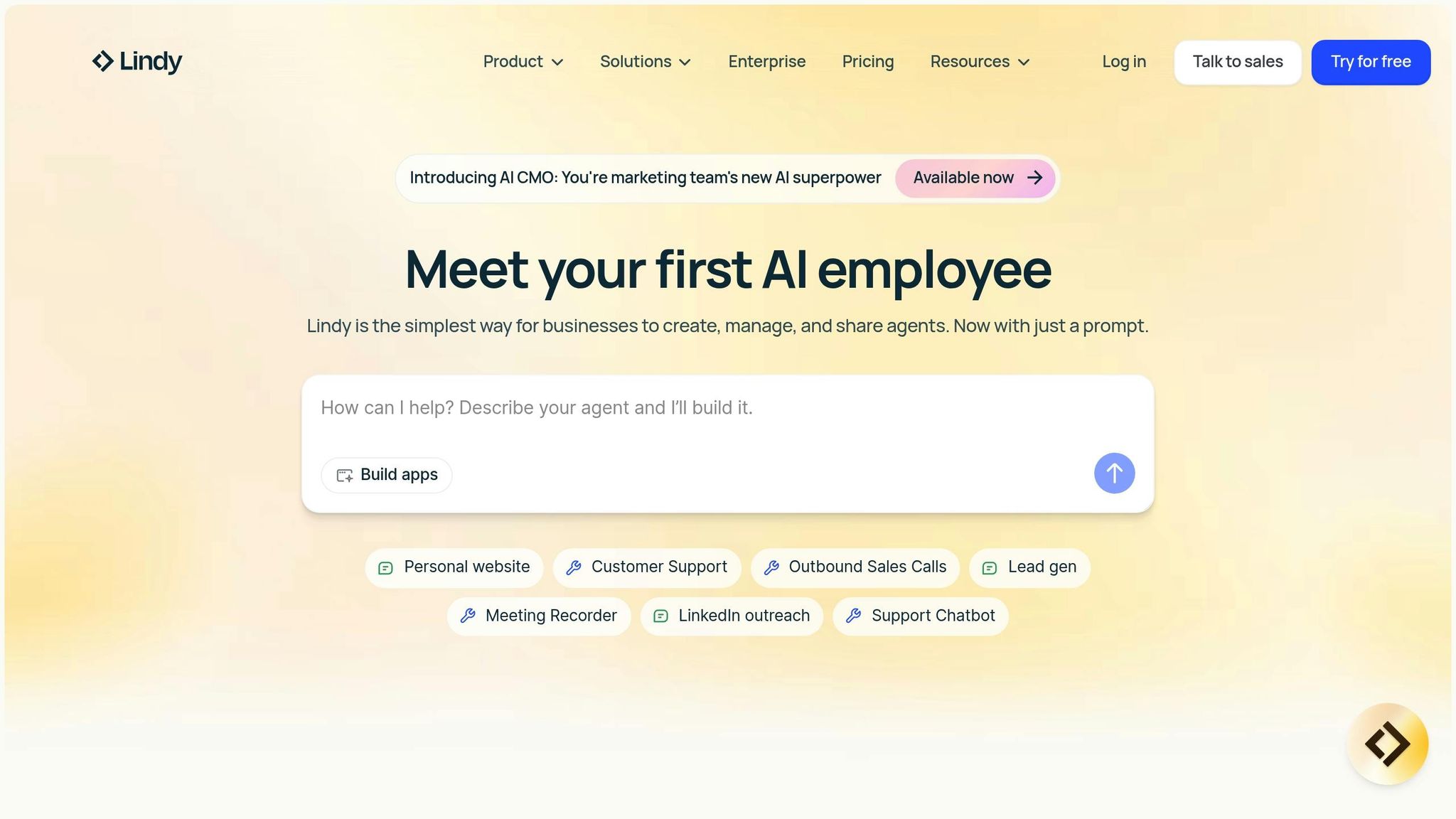
Lindy AI operates using an agent-based system where individual agents collaborate to complete tasks. This setup is crafted to establish autonomous workflows capable of making decisions with minimal human input, helping teams simplify and automate routine AI-driven operations.
The platform’s agent system is built to function with a variety of AI models, enabling each agent to be tailored to the specific needs of its assigned task. This adaptability ensures optimized performance while keeping costs in check.
Lindy AI also includes a connector library that integrates with a wide range of business applications, such as customer relationship management systems and popular productivity tools. By offering this broad connectivity, teams can design workflows that span across multiple systems without requiring custom API development.
One standout feature is its natural language configuration. Users can simply describe tasks in plain language - such as instructing an agent to monitor a support inbox, sort tickets by urgency, and escalate critical issues to the right team member. The system then converts these instructions into actionable workflow logic, making it easier to create scalable and efficient processes.
Lindy AI’s architecture is designed to grow alongside workflow complexity. Teams can start small with straightforward, single-agent tasks and gradually expand to advanced, multi-agent systems capable of managing entire business processes. The platform also supports parallel processing, where multiple agents handle different parts of a workflow simultaneously. For example, agents could manage inquiries, update records, and generate follow-ups all at once, significantly cutting down processing time.
Agents are equipped to respond intelligently to data using conditional logic and decision trees. For instance, an agent handling invoices might automatically escalate high-value transactions to finance managers while processing routine payments independently. This reduces the need for constant human oversight.
Moreover, Lindy AI’s agents improve over time by learning from previous decisions and outcomes. This adaptive capability is especially beneficial for customer service workflows, where enhanced categorization and quicker responses to common issues can boost overall efficiency.
Lindy AI provides detailed cost tracking at the agent level, breaking down expenses by factors such as model usage, API calls, and processing time. This transparency gives teams a clear understanding of their AI-related spending.
The platform also includes tools for forecasting expenses based on historical workflow data, helping teams plan budgets and allocate resources effectively. Additionally, spending limits can be set for individual agents or workflows, ensuring processes pause automatically if budgets are exceeded. Intelligent model selection further enhances cost-efficiency by identifying the most economical AI model for each task.
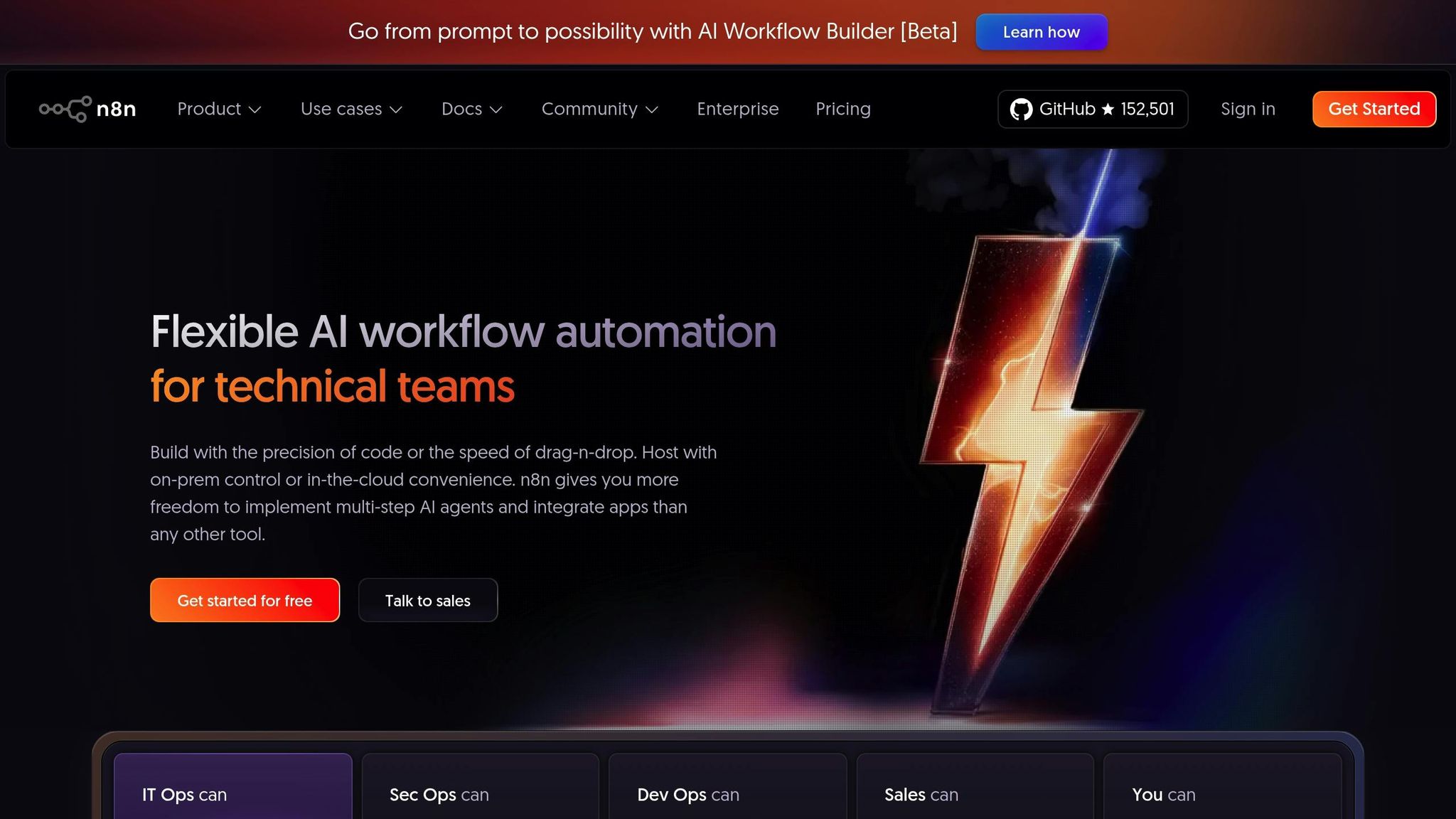
n8n is a versatile, node-based platform designed for automating workflows, particularly those involving AI. It combines a user-friendly visual workflow builder with the flexibility to embed custom code, making it suitable for both technical teams and non-technical users.
One of n8n's standout features is its ability to integrate with a wide variety of tools and services. With 500+ native integrations, users can connect AI services, business applications, databases, and online tools without the need for custom development. For AI-specific workflows, the platform's HTTP Request node serves as a universal connector, enabling interaction with virtually any REST API, including custom-built AI models. Additionally, the MCP Server Trigger allows external AI systems to directly invoke workflows, enabling two-way communication for more complex automation tasks.
n8n also facilitates the creation of multi-agent systems, allowing multiple AI agents to collaborate seamlessly within a single workflow.
n8n's hybrid no-code/low-code editor is designed for flexibility, allowing users to drag and drop nodes while embedding custom JavaScript or Python for more specialized logic. This makes it suitable for a wide range of applications, from simple integrations to advanced workflows requiring tailored programming.
Its event-driven and branching architecture adjusts dynamically to AI outputs, making it capable of handling high-volume operations efficiently. Whether you need a lightweight setup or a more robust system, n8n adapts to your requirements. It can be self-hosted for complete control or accessed as a cloud service, eliminating the need for infrastructure management.
n8n is built with features to help manage and optimize AI-related costs. Event-driven triggers ensure that AI models are only activated when specific conditions are met, reducing unnecessary compute usage. Error triggers with fallback logic can reroute requests or pause processes to prevent budget overruns, and workflows can even switch to more cost-effective AI models when necessary.
For enterprise users, n8n offers advanced tools like custom log streaming to aggregators for detailed cost tracking. It also integrates with Git-based deployment systems, making updates and rollbacks easier to manage while maintaining clear visibility into expenses. Additionally, its human-in-the-loop functionality ensures that resource-intensive AI operations can require manual approval before execution, adding another layer of cost control.
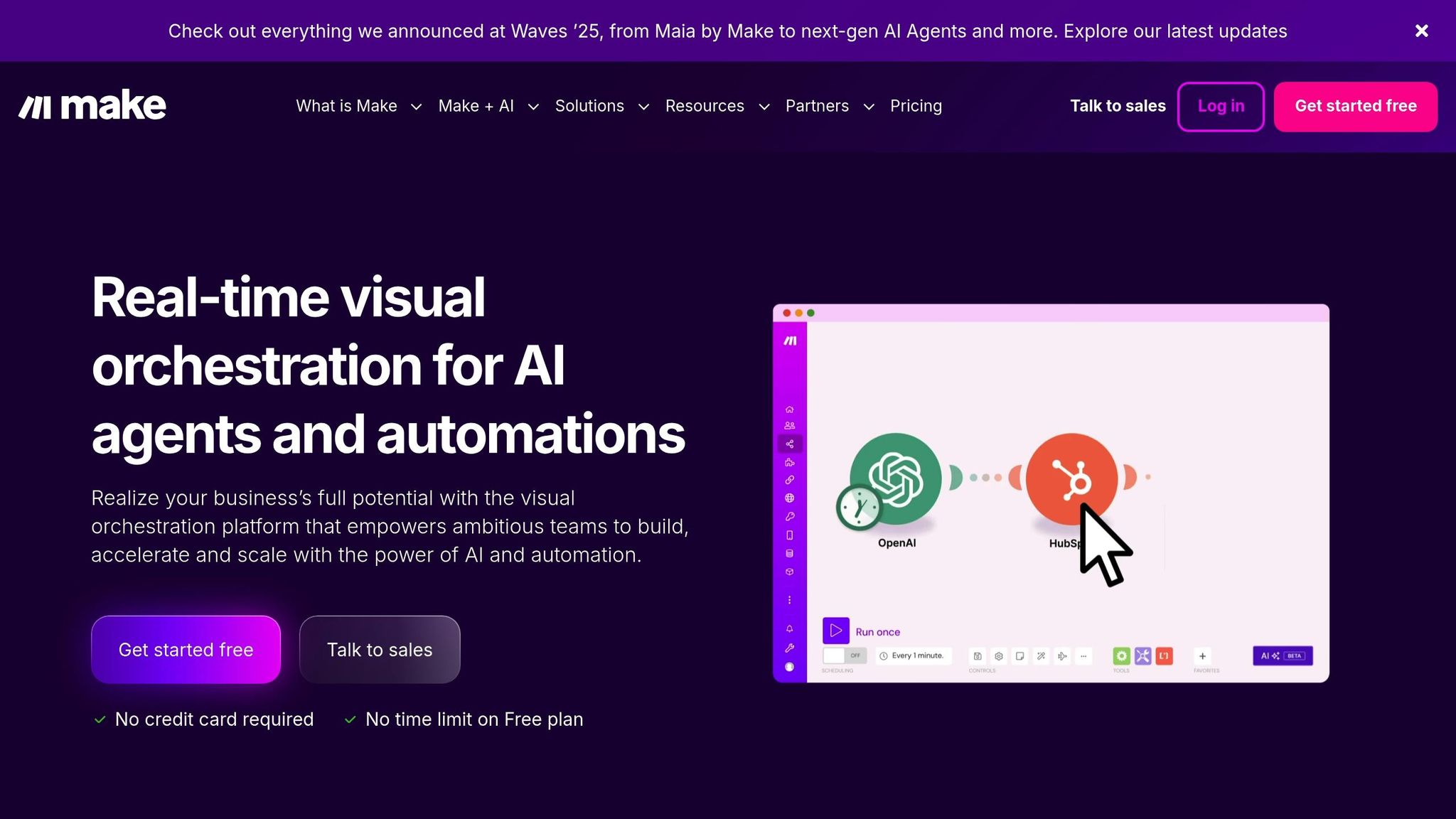
Make is a user-friendly drag-and-drop platform designed to automate workflows across various tools and systems - no coding required. Here’s how it simplifies connectivity, scales to meet diverse needs, and keeps costs under control.
Make's extensive integration library, webhook-enabled API access, and customizable templates make connecting and tailoring workflows a breeze. With its growing collection of AI modules, you can handle tasks like content creation, translation, text generation, classification, and data routing. Advanced data transformation features ensure smooth communication between different systems.
Its intuitive visual interface supports everything from straightforward automations to intricate workflows. With features like conditional logic, branching paths, and multi-step sequences, Make adapts to both small tasks and large-scale data processing.
Make keeps pricing straightforward, offering a free plan for beginners and paid options starting at $9/month when billed annually. The visual builder helps identify bottlenecks and fine-tune resource usage, making automation both efficient and cost-effective. It’s no surprise Make earns a 4.5/5 rating on G2 for its ability to deliver powerful automation while keeping costs manageable.
Finding the right AI workflow management tool means balancing powerful features with a pricing plan that fits your needs. Prompts.ai is designed to simplify AI orchestration, offering clear cost insights and flexible options for scalable usage. Below is a breakdown of the platform's plans, showcasing its commitment to affordability and functionality.
| Plan Category | Starting Price | Ideal For | Key Features |
|---|---|---|---|
| Personal – Pay As You Go | $0/month | Solo projects and initial experimentation | Free access to a unified platform with a wide range of AI models |
| Personal – Creator | $29/month | Individual users seeking advanced tools | AI toolkit with straightforward, usage-based pricing |
| Personal – Family | $99/month | Home or small team collaboration | Group access to AI tools designed for teamwork and shared projects |
| Business – Core | $99 per member/month | Teams needing secure AI orchestration | Multi-team management, enhanced security, and real-time FinOps tracking |
| Business – Pro | $119 per member/month | Knowledge workers and larger teams | Advanced performance metrics, robust security, and compliance capabilities |
| Business – Elite | $129 per member/month | Creative teams requiring full integration | Comprehensive AI orchestration, collaboration tools, and dedicated support |
Prompts.ai's pricing model is tailored to help organizations optimize their AI processes while keeping costs manageable. Starting at $0/month, users can grow into more advanced plans, with detailed FinOps tracking enabling up to 98% savings on AI software expenses. Whether you're exploring AI for the first time or managing intricate workflows, Prompts.ai offers a solution that aligns with both your technical needs and budget.
When selecting an AI workflow platform, focus on finding a solution that genuinely transforms your organization rather than simply adding new features. With AI-enabled workflows projected to surge from 3% to 25% of all enterprise processes by the end of 2025, the pressure to make the right choice has never been greater.
The benefits of interoperable AI platforms are clear. Companies using such platforms have reported up to a 25% boost in productivity and a 30% improvement in efficiency. Additionally, integrated platforms have led to a 40–60% reduction in human errors. Faster AI orchestration - up to 40% - and 30% lower integration costs are also among the advantages of embracing interoperability.
To make an informed decision, evaluate potential platforms based on three key factors. First, choose a platform that seamlessly embeds AI technologies like machine learning, natural language processing, and generative AI into your existing workflows. Second, ensure the platform can scale effectively, maintaining high performance even when managing thousands of concurrent workflows. Finally, look for flexibility in integrations, ensuring compatibility with your current CRM, ERP, and database systems.
Interoperability is critical for avoiding vendor lock-in. Platforms that support standardized protocols, such as Agent-to-Agent (A2A) and Mesh Communication Protocol (MCP), enable different AI systems to coordinate workflows and share information without requiring human intervention. This adaptability ensures your investment remains relevant as AI technology evolves.
The momentum behind AI adoption is undeniable - 74% of organizations expect AI to be integrated into all enterprise applications within three years. Those that carefully assess their needs and capabilities are 2.3 times more likely to meet their automation goals on schedule. Take the time to align your choice with your specific requirements, financial considerations, and long-term goals.
The right AI workflow platform will be a cornerstone for your organization's AI-driven future. Whether you're managing a small team or overseeing enterprise-wide operations, select a solution that scales with your growth, safeguards your data, and delivers tangible results.
A unified AI workflow platform can drastically cut costs and improve efficiency by automating routine tasks, minimizing the need for manual effort. This approach not only saves time but also trims operational expenses by an impressive 20–40%, while increasing productivity by as much as 30%.
These platforms also simplify operations by bringing together various tools and removing duplicate software, which can lower software and maintenance costs by 10–30%. By refining workflows and enabling smooth integration, businesses can scale their operations efficiently without incurring excessive overhead.
When selecting an AI workflow management tool, security and compliance should be at the top of your checklist to protect both your data and operations. Opt for tools that offer robust features like data encryption, role-based access control (RBAC), and multi-factor authentication (MFA) to safeguard sensitive information. It's also important to choose platforms that support secure API integrations and include model lifecycle security measures, such as input validation and drift monitoring, to maintain the integrity of your AI systems.
Equally important is ensuring strong governance and oversight. Look for tools that enforce policies, provide accountability, and allow for human oversight in critical processes. Features like continuous monitoring, anomaly detection, and real-time alerts can further strengthen security while keeping your workflows compliant with industry regulations. By prioritizing these elements, you can establish a secure and dependable AI operation.
Prompts.ai is built to grow with your needs, whether you're a small team or a large enterprise. By automating workflows across departments and cutting down on repetitive tasks, it streamlines operations while promoting smooth collaboration. Plus, teams can directly compare top LLMs side by side, helping to boost productivity and refine processes.
With flexible plans designed for various team sizes, the platform offers features like unlimited workspaces, collaborators, and scalable storage and credits. This adaptability allows businesses to respond swiftly to evolving demands and transform fixed costs into efficient, on-demand solutions.


